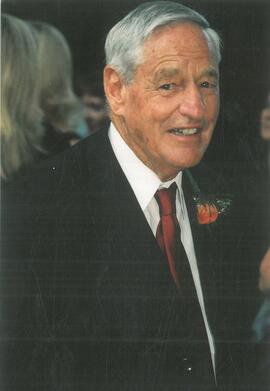Interview with Aubrey Chalmers 1955
- ZA ZAR STDS 202000707
- Item
- 2015
Interview with Aubrey Chalmers – 1955
Aubrey’s grandfather attended MBC in Victoria, Australia in the late 1800’s and his father was a pupil at
MBC, Koch Street and his uncle was head boy of Marist Brothers Observatory in 1928.
Aubrey came to St David’s in 1949 in standard 4, his first teacher was Mrs Kempster and the headmaster
was Brother Edwin. Other brothers that he remembers who were at the school at the time were Bothers
Ernest, Benedict, Aquinas (head of Koch Street, “Bulldog”), Alban, Matthew, Pius, Br Gerald and Br Ralph
who taught Afrikaans was a brilliant rugby coach and was nicknamed “BeeGee”. Another brother who
taught Latin and Maths was nicknamed “Caesar”.
Br Edwin was a great disciplinarian but the boys loved and respected him – the atmosphere grew very quiet
when he was around and you could hear a pin drop. Aubrey respected Br Edwin and found him to be
straight forward. Although he was a sick man he had a good sense of humour and kept good control of the
school.
Aubrey remembered when he received six of the best after an incident in the dining room during grace with
the usual competition to gain possession of the milk jug from another boy. Aubrey ended up suddenly
holding the jug as the other boy released his hold and the jug’s contents shot over his shoulder and Br
Benedict ended up totally white.
On his first day the boys were up at 6.00am, shower, breakfast followed by line up and they finished school
work by 2.45pm, had tea went to the dorms and changed into sports gear.
There were 4 dormitories accommodating 44 boys with a brother responsible for each dorm. There were
boys from all over including Mozambique, Zambia, Rhodesia and Angola. On Friday nights matron Mrs
Knight randomly selected boys for a dose of castor oil
Once the boys were playing mini cricket in the dorm with Br Alban using a golf ball which involved breaking
a window and a hapless, rather studious boy who read a lot ended up taking the blame.
Aubrey was a swimmer, age group champion and was a member of Malvern Swimming Club. He swam for
the Transvaal after leaving school. In athletics, Aubrey was mainly a hurdler, represented the school and
was champion until U15. Aubrey also played rugby. As a boarder the boys did everything. Because of the
school’s low numbers the school only had A and B teams. The rugby team played Obs, Jeppe, KES, CBC
Boksburg, Springs and Germiston Boys High, Forest High and Parktown Boys. Obs and Inanda combined
to swim in the high school galas at Ellis park and always came second with KES being the top school.
There were few tours in those days and in 1955 SACS came up from Cape Town with the 1st XV rugby
team with boys from their 6th form – who were already shaving!
Specific events that Aubrey remembers are the day Marcellin Champagnat was beatified, a special
occasion and Aubrey still has the key ring commemorating the day; beating KES at rugby, the annual
triangular with Germiston Boys High, Springs Boys High and Marist Brothers Inanda.
Aubrey was in the school choir and participated in “HMS Pinafore” directed by Mr Drummond-Bell.
Aubrey’s class of 24 was the largest matric class and the school’s total numbers were around 200 boys. In
a “Spotlight on the matrics of ‘55”, Aubrey was elected the Best Storyteller.
Boys at school with him were Graeme Talbot, Errol Goeller, Andrew Oakes, Richard Rowan Irwin (who
gained the highest marks in law that Wits University had ever seen), Robin Manners, Brunton was head
boy and another boy Michael Finger was nicknamed “Tom Thumb”.
Aubrey was never unhappy and enjoyed his schooldays it was a lovely environment to be in with a good
upbringing. Aubrey was upset when Br Urban died and another sad incident was when a young pupil
Barrenbrugg died in a motor accident outside the school.
Aubrey wasn’t awarded colours mainly because of the polio outbreak and sporting events were cancelled.
Ian Kirley who was also awarded the provincial blazer was head boy for two years – in 1952 colours were
taken away and several boys were demoted. Br Edwin appointed Kirley in standard 9, there was a big
shake up in the school.
In his matric year Aubrey had decided to become a brother but during the course of the year he decided
against it and went instead to Wits University and studied for a Higher Diploma in Clinical pathology. He
was initially going to study pharmacy but after a stint working in a pharmacy during the holidays decided
that he would be a glorified shop assistant. He eventually became a clinical pathologist involved with
medical research and was the head technologist at the Blood Transfusion Service from 1963 to 1983
producing albumen. Later he was employed by Millipool, a US company until 2000 and spent 4 months in
Boston. Aubrey has worked in Wadeville for the past 11 years with Clinx Waste Management.
Aubrey’s wife is a nursing sister and they had two sons who were unable to attend St David’s as they lived
in Germiston at the time and there was no longer a boarding facility.
JLE February 2015
Egenrieder, Julie


